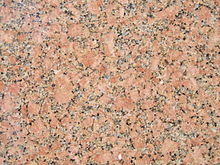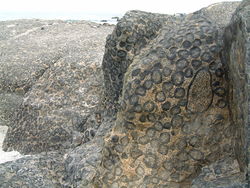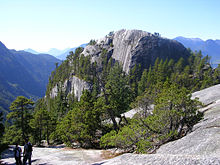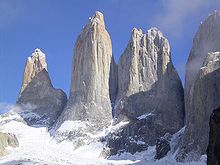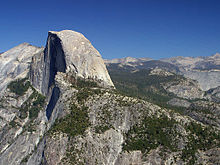- Granite
-
For other uses, see Granite (disambiguation).
Granite Igneous Rock
Granite containing potassium feldspar, plagioclase feldspar, quartz, and biotite and/or amphiboleComposition Potassium feldspar, plagioclase feldspar, and quartz; differing amounts of muscovite, biotite, and hornblende-type amphiboles. Granite (
 /ˈɡrænɨt/) is a common and widely occurring type of intrusive, felsic, igneous rock. Granite usually has a medium- to coarse-grained texture. Occasionally some individual crystals (phenocrysts) are larger than the groundmass, in which case the texture is known as porphyritic. A granitic rock with a porphyritic texture is sometimes known as a porphyry. Granites can be pink to gray in color, depending on their chemistry and mineralogy. By definition, granite is an igneous rock with at least 20% quartz by volume. Granite differs from granodiorite in that at least 35% of the feldspar in granite is alkali feldspar as opposed to plagioclase; it is the alkali feldspar that gives many granites a distinctive pink color. Outcrops of granite tend to form tors and rounded massifs. Granites sometimes occur in circular depressions surrounded by a range of hills, formed by the metamorphic aureole or hornfels. Granite is usually found in the continental plates of the Earth's crust.
/ˈɡrænɨt/) is a common and widely occurring type of intrusive, felsic, igneous rock. Granite usually has a medium- to coarse-grained texture. Occasionally some individual crystals (phenocrysts) are larger than the groundmass, in which case the texture is known as porphyritic. A granitic rock with a porphyritic texture is sometimes known as a porphyry. Granites can be pink to gray in color, depending on their chemistry and mineralogy. By definition, granite is an igneous rock with at least 20% quartz by volume. Granite differs from granodiorite in that at least 35% of the feldspar in granite is alkali feldspar as opposed to plagioclase; it is the alkali feldspar that gives many granites a distinctive pink color. Outcrops of granite tend to form tors and rounded massifs. Granites sometimes occur in circular depressions surrounded by a range of hills, formed by the metamorphic aureole or hornfels. Granite is usually found in the continental plates of the Earth's crust.Granite is nearly always massive (lacking internal structures), hard and tough, and therefore it has gained widespread use as a construction stone. The average density of granite is between 2.65[1] and 2.75 g/cm3, its compressive strength usually lies above 200 MPa, and its viscosity at standard temperature and pressure is 3-6 • 1019 Pa·s.[2]
The word granite comes from the Latin granum, a grain, in reference to the coarse-grained structure of such a crystalline rock.
Granitoid is a general, descriptive field term for light-colored, coarse-grained igneous rocks. Petrographic examination is required for identification of specific types of granitoids.[3]
Contents
Mineralogy
Granite is classified according to the QAPF diagram for coarse grained plutonic rocks and is named according to the percentage of quartz, alkali feldspar (orthoclase, sanidine, or microcline) and plagioclase feldspar on the A-Q-P half of the diagram. True granite according to modern petrologic convention contains both plagioclase and alkali feldspars. When a granitoid is devoid or nearly devoid of plagioclase, the rock is referred to as alkali granite. When a granitoid contains less than 10% orthoclase, it is called tonalite; pyroxene and amphibole are common in tonalite. A granite containing both muscovite and biotite micas is called a binary or two-mica granite. Two-mica granites are typically high in potassium and low in plagioclase, and are usually S-type granites or A-type granites. The volcanic equivalent of plutonic granite is rhyolite. Granite has poor primary permeability but strong secondary permeability.
Chemical composition
A worldwide average of the chemical composition of granite, by weight percent:[4]
- SiO2 — 72.04% (silica)
- Al2O3 — 14.42% (alumina)
- K2O — 4.12%
- Na2O — 3.69%
- CaO — 1.82%
- FeO — 1.68%
- Fe2O3 — 1.22%
- MgO — 0.71%
- TiO2 — 0.30%
- P2O5 — 0.12%
- MnO — 0.05%
Based on 2485 analyses
Occurrence
Granite is currently known only on Earth, where it forms a major part of continental crust. Granite often occurs as relatively small, less than 100 km² stock masses (stocks) and in batholiths that are often associated with orogenic mountain ranges. Small dikes of granitic composition called aplites are often associated with the margins of granitic intrusions. In some locations, very coarse-grained pegmatite masses occur with granite.
Granite has been intruded into the crust of the Earth during all geologic periods, although much of it is of Precambrian age. Granitic rock is widely distributed throughout the continental crust and is the most abundant basement rock that underlies the relatively thin sedimentary veneer of the continents.
Origin
Granite is an igneous rock and is formed from magma. Granitic magma has many potential origins but it must intrude other rocks. Most granite intrusions are emplaced at depth within the crust, usually greater than 1.5 kilometres and up to 50 km depth within thick continental crust. The origin of granite is contentious and has led to varied schemes of classification. Classification schemes are regional and include French, British, and American systems.
Geochemical origins
Granitoids are a ubiquitous component of the crust. They have crystallized from magmas that have compositions at or near a eutectic point (or a temperature minimum on a cotectic curve). Magmas will evolve to the eutectic because of igneous differentiation, or because they represent low degrees of partial melting. Fractional crystallisation serves to reduce a melt in iron, magnesium, titanium, calcium and sodium, and enrich the melt in potassium and silicon - alkali feldspar (rich in potassium) and quartz (SiO2), are two of the defining constituents of granite.
This process operates regardless of the origin of the parental magma to the granite, and regardless of its chemistry. However, the composition and origin of the magma which differentiates into granite, leaves certain geochemical and mineral evidence as to what the granite's parental rock was. The final mineralogy, texture and chemical composition of a granite is often distinctive as to its origin. For instance, a granite which is formed from melted sediments may have more alkali feldspar, whereas a granite derived from melted basalt may be richer in plagioclase feldspar. It is on this basis that the modern "alphabet" classification schemes are based.
Chappell & White classification system
The letter-based Chappell & White classification system was proposed initially to divide granites into I-type granite (or igneous protolith) granite and S-type or sedimentary protolith granite.[5] Both of these types of granite are formed by melting of high grade metamorphic rocks, either other granite or intrusive mafic rocks, or buried sediment, respectively.
M-type or mantle derived granite was proposed later, to cover those granites which were clearly sourced from crystallized mafic magmas, generally sourced from the mantle. These are rare, because it is difficult to turn basalt into granite via fractional crystallisation.
A-type or anorogenic granites are formed above volcanic "hot spot" activity and have peculiar mineralogy and geochemistry. These granites are formed by melting of the lower crust under conditions that are usually extremely dry. The rhyolites of the Yellowstone caldera are examples of volcanic equivalents of A-type granite.[6][7]
Granitization
An old, and largely discounted theory, granitization states that granite is formed in place by extreme metasomatism by fluids bringing in elements e.g. potassium and removing others e.g. calcium to transform the metamorphic rock into a granite. This was supposed to occur across a migrating front. The production of granite by metamorphic heat is difficult, but is observed to occur in certain amphibolite and granulite terrains. In-situ granitisation or melting by metamorphism is difficult to recognise except where leucosome and melanosome textures are present in gneisses. Once a metamorphic rock is melted it is no longer a metamorphic rock and is a magma, so these rocks are seen as a transitional between the two, but are not technically granite as they do not actually intrude into other rocks. In all cases, melting of solid rock requires high temperature, and also water or other volatiles which act as a catalyst by lowering the solidus temperature of the rock.
Ascent and emplacement
The ascent and emplacement of large volumes of granite within the upper continental crust is a source of much debate amongst geologists. There is a lack of field evidence for any proposed mechanisms, so hypotheses are predominantly based upon experimental data. There are two major hypotheses for the ascent of magma through the crust:
- Stokes Diapir
- Fracture Propagation
Of these two mechanisms, Stokes diapir was favoured for many years in the absence of a reasonable alternative. The basic idea is that magma will rise through the crust as a single mass through buoyancy. As it rises it heats the wall rocks, causing them to behave as a power-law fluid and thus flow around the pluton allowing it to pass rapidly and without major heat loss.[8] This is entirely feasible in the warm, ductile lower crust where rocks are easily deformed, but runs into problems in the upper crust which is far colder and more brittle. Rocks there do not deform so easily: for magma to rise as a pluton it would expend far too much energy in heating wall rocks, thus cooling and solidifying before reaching higher levels within the crust.
Nowadays fracture propagation is the mechanism preferred by many geologists as it largely eliminates the major problems of moving a huge mass of magma through cold brittle crust. Magma rises instead in small channels along self-propagating dykes which form along new or pre-existing fault systems and networks of active shear zones (Clemens, 1998).[9] As these narrow conduits open, the first magma to enter solidifies and provides a form of insulation for later magma.
Granitic magma must make room for itself or be intruded into other rocks in order to form an intrusion, and several mechanisms have been proposed to explain how large batholiths have been emplaced:
- Stoping, where the granite cracks the wall rocks and pushes upwards as it removes blocks of the overlying crust
- Assimilation, where the granite melts its way up into the crust and removes overlying material in this way
- Inflation, where the granite body inflates under pressure and is injected into position
Most geologists today accept that a combination of these phenomena can be used to explain granite intrusions, and that not all granites can be explained entirely by one or another mechanism.
Natural radiation
Granite is a natural source of radiation, like most natural stones. However, some granites have been reported to have higher radioactivity thereby raising some concerns about their safety.
Some granites contain around 10 to 20 parts per million of uranium. By contrast, more mafic rocks such as tonalite, gabbro or diorite have 1 to 5 ppm uranium, and limestones and sedimentary rocks usually have equally low amounts. Many large granite plutons are the sources for palaeochannel-hosted or roll front uranium ore deposits, where the uranium washes into the sediments from the granite uplands and associated, often highly radioactive, pegmatites. Granite could be considered a potential natural radiological hazard as, for instance, villages located over granite may be susceptible to higher doses of radiation than other communities.[10] Cellars and basements sunk into soils over granite can become a trap for radon gas, which is formed by the decay of uranium.[11] Radon can also be introduced into houses by wells drilled into granite.[12] Radon gas poses significant health concerns, and is the number two cause of lung cancer in the US behind smoking.[12]
There is some concern that materials sold as granite countertops or as building material may be hazardous to health. Dan Steck of St. Johns University, has stated[13] that approximately 5% of all granites will be of concern, with the caveat that only a tiny percentage of the tens of thousands of granite slabs have been tested. Various resources from national geological survey organizations are accessible online to assist in assessing the risk factors in granite country and design rules relating, in particular, to preventing accumulation of radon gas in enclosed basements and dwellings.
A study of granite countertops was done (initiated and paid for by the Marble Institute of America) in November 2008 by National Health and Engineering Inc of USA, and found that all of the 39 full size granite slabs that were measured for the study showed radiation levels well below the European Union safety standards (section 4.1.1.1 of the National Health and Engineering study) and radon emission levels well below the average outdoor radon concentrations in the US.[14]
Uses
Antiquity
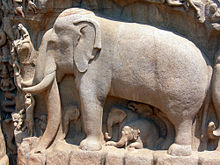 Life-size elephant and other creatures carved in granite; Mahabalipuram, India.
Life-size elephant and other creatures carved in granite; Mahabalipuram, India.
The Red Pyramid of Egypt (c.26th century BC), named for the light crimson hue of its exposed granite surfaces, is the third largest of Egyptian pyramids. Menkaure's Pyramid, likely dating to the same era, was constructed of limestone and granite blocks. The Great Pyramid of Giza (c.2580 BC) contains a huge granite sarcophagus fashioned of "Red Aswan Granite." The mostly ruined Black Pyramid dating from the reign of Amenemhat III once had a polished granite pyramidion or capstone, now on display in the main hall of the Egyptian Museum in Cairo (see Dahshur). Other uses in Ancient Egypt include columns, door lintels, sills, jambs, and wall and floor veneer.[15] How the Egyptians worked the solid granite is still a matter of debate. Dr. Patrick Hunt[16] has postulated that the Egyptians used emery shown to have higher hardness on the Mohs scale.
Many large Hindu temples in southern India, particularly those built by the 11th century king Rajaraja Chola I, were made of granite. There is a large amount of granite in these structures. They are comparable to the Great Pyramid of Giza.[17]
Modern
Building
 Quarrying granite for the Mormon Temple, Utah Territory, in Little Cottonwood Canyon
Quarrying granite for the Mormon Temple, Utah Territory, in Little Cottonwood Canyon
 Granite was used for cobblestones on the St. Louis riverfront and for the piers of the Eads Bridge (background).
Granite was used for cobblestones on the St. Louis riverfront and for the piers of the Eads Bridge (background).
Granite has been extensively used as a dimension stone and as flooring tiles in public and commercial buildings and monuments. Aberdeen in Scotland, which is constructed principally from local granite, is known as "The Granite City". Because of its abundance, granite was commonly used to build foundations for homes in New England. The Granite Railway, America's first railroad, was built to haul granite from the quarries in Quincy, Massachusetts, to the Neponset River in the 1820s. With increasing amounts of acid rain in parts of the world, granite has begun to supplant marble as a monument material, since it is much more durable. Polished granite is also a popular choice for kitchen countertops due to its high durability and aesthetic qualities. In building and for countertops, the term "granite" is often applied to all igneous rocks with large crystals, and not specifically to those with a granitic composition.
Engineering
Engineers have traditionally used polished granite surfaces to establish a plane of reference, since they are relatively impervious and inflexible. Sandblasted concrete with a heavy aggregate content has an appearance similar to rough granite, and is often used as a substitute when use of real granite is impractical. A most unusual use of granite was in the construction of the rails for the Haytor Granite Tramway, Devon, England, in 1820. Granite block is usually processed into slabs and after can be cut and shaped by a cutting center.
Other uses
In some areas granite is used for gravestones and memorials. Granite is a hard stone and requires skill to carve by hand. Modern methods of carving include using computer-controlled rotary bits and sandblasting over a rubber stencil. Leaving the letters, numbers and emblems exposed on the stone, the blaster can create virtually any kind of artwork or epitaph.
Curling stones are traditionally fashioned of Ailsa Craig granite. The first stones were made in the 1750s, the original source being Ailsa Craig in Scotland. Because of the particular rarity of the granite, the best stones can cost as much as US$1,500. Between 60–70 percent of the stones used today are made from Ailsa Craig granite, although the island is now a wildlife reserve and is no longer used for quarrying.[18]
Rock climbing
Granite is one of the rocks most prized by climbers, for its steepness, soundness, crack systems, and friction. Well-known venues for granite climbing include Yosemite, the Bugaboos, the Mont Blanc massif (and peaks such as the Aiguille du Dru, the Mountains of Mourne, the Aiguille du Midi and the Grandes Jorasses), the Bregaglia, Corsica, parts of the Karakoram (especially the Trango Towers), the Fitzroy Massif, Patagonia, Baffin Island, Ogawayama, the Cornish coast and the Cairngorms.
Granite rock climbing is so popular that many of the artificial rock climbing walls found in gyms and theme parks are made to look and feel like granite.
See also
- Epoxy granite
- Falkenfelsen, or Falcon Rock
- Fall River granite
- Greisen
- Hypersolvus
- Igneous rocks
- List of rock types
- Luxullianite
- Mourne Mountains
- Orbicular granite
- Pikes Peak granite, Colorado
- Quartz monzonite
- Rapakivi granite
- Stone Mountain, Georgia
- Subsolvus
- Wicklow Mountains, Ireland
- Cold Spring Granite
References
- ^ "Basic Rock Mechanics". Webpages.sdsmt.edu. http://webpages.sdsmt.edu/~lstetler/merlot/rock_mechanics.htm. Retrieved 2010-05-09.
- ^ Kumagai, Naoichi; Sadao Sasajima, Hidebumi Ito (15 February 1978). "Long-term Creep of Rocks: Results with Large Specimens Obtained in about 20 Years and Those with Small Specimens in about 3 Years". Journal of the Society of Materials Science (Japan) (Japan Energy Society) 27 (293): 157–161. http://translate.google.com/translate?hl=en&sl=ja&u=http://ci.nii.ac.jp/naid/110002299397/&sa=X&oi=translate&resnum=4&ct=result&prev=/search%3Fq%3DIto%2BHidebumi%26hl%3Den. Retrieved 2008-06-16.
- ^ "Granitoids - Granite and the Related Rocks Granodiorite, Diorite and Tonalite". Geology.about.com. 2010-02-06. http://geology.about.com/od/more_igrocks/a/granitoids.htm. Retrieved 2010-05-09.
- ^ Harvey Blatt and Robert J. Tracy (1997). Petrology (2nd ed.). New York: Freeman. p. 66. ISBN 0-7167-2438-3.
- ^ Chappell, B.W. and White, A.J.R., 2001. Two contrasting granite types: 25 years later. Australian Journal of Earth Sciences v.48, p.489-499.
- ^ Boroughs, S., Wolff, J., Bonnichsen, B., Godchaux, M., and Larson, P., 2005, Large-volume, low-δ18O rhyolites of the central Snake River Plain, Idaho, USA: Geology 33: 821–824.
- ^ C.D. Frost, M. McCurry, R. Christiansen, K. Putirka and M. Kuntz, Extrusive A-type magmatism of the Yellowstone hot spot track 15th Goldschmidt Conference Field Trip AC-4. Field Trip Guide, University of Wyoming (2005) 76 pp., plus an appended map.
- ^ Weinberg, R. F., and Podladchikov, Y., Diapiric ascent of magmas through power-law crust and mantle, 1994, J. Geophys. Res., 99, 9543-9559
- ^ Clemens, John (1998). "Observations on the origins and ascent mechanisms of granitic magmas". Journal of the Geological Society of London 155 (Part 5): 843–51. doi:10.1144/gsjgs.155.5.0843.
- ^ "Radiation and Life". World Nuclear Association. July 2002. http://world-nuclear.org/education/ral.htm. Retrieved 2010-02-04.
- ^ "Decay series of Uranium". http://www.world-nuclear.org/images/info/decayseries.gif. Retrieved 2008-10-19.
- ^ a b "Radon and Cancer: Questions and Answers". National Cancer Institute. http://www.cancer.gov/cancerTopics/factsheet/Risk/radon. Retrieved 2008-10-19.
- ^ Steck, Daniel J. (2009). "Pre- and Post-Market Measurements of Gamma Radiation and Radon Emanation from a Large Sample of Decorative Granites". http://www.aarst.org/proceedings/2009/PRE-AND_POST-MARKET_MEASUREMENTS_OF_GAMMA_RADIATION_AND_RADON_EMANATION_FROM_A_LARGE_SAMPLE_OF_DECORATIVE_GRANITES.pdf.
- ^ Natural Stone Countertops and Radon - Environmental Health and Engineering - Assessing Exposure to Radon and Radiation from Granite Countertops.
- ^ James A. Harrell. "Decorative Stones in the Pre-Ottoman Islamic Buildings of Cairo, Egypt". http://www.eeescience.utoledo.edu/Faculty/Harrell/Egypt/Mosques/CAIRO_Rocks_1.htm. Retrieved 2008-01-06.
- ^ "Egyptian Genius: Stoneworking for Eternity". http://hebsed.home.comcast.net/hunt.htm. Retrieved 2008-01-06.
- ^ "The Lost Temples of India" (video). http://video.google.com/videoplay?docid=8931191297840928556&q=Lost+temples+India. Retrieved 2008-01-06.
- ^ "National Geographic News — Puffins Return to Scottish Island Famous for Curling Stones". News.nationalgeographic.com. http://news.nationalgeographic.com/news/2004/10/1027_041027_curling_stones.html. Retrieved 2009-07-30.
External links
Igneous rocks by composition Type Ultramafic
< 45% SiO2Mafic
45-52% SiO2Intermediate
52–63% SiO2Intermediate-Felsic
63–69% SiO2Felsic
>69 % SiO2Volcanic rocks:
Subvolcanic rocks:
Plutonic rocks:Stonemasonry Types Materials List of stone • Artificial stone • Brick • Cast stone • Decorative stones • Dimension stone • Fieldstone • Flagstone • Gabions • Granite • Marble • Mortar • Sandstone • SlateTools Angle grinder • Bush hammer • Ceramic tile cutter • Chisel • Diamond blade • Lewis (lifting appliance) • Non-explosive demolition agents • Plug and feather • Stonemason's hammer • StraightedgeTechniques Products Organizations Categories:- Granitic rocks
- Felsic rocks
- Symbols of Wisconsin
- Plutonic rocks
- National symbols of Finland
Wikimedia Foundation. 2010.

